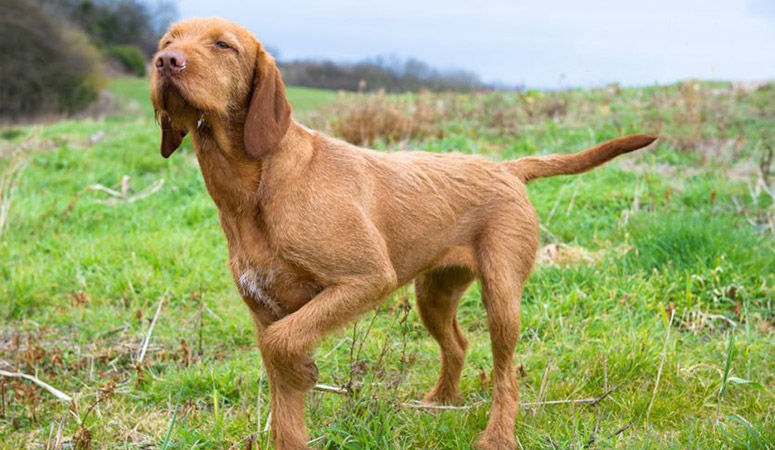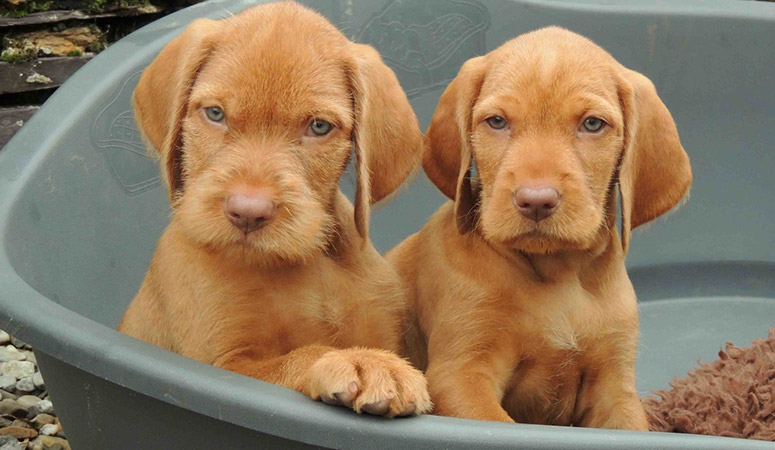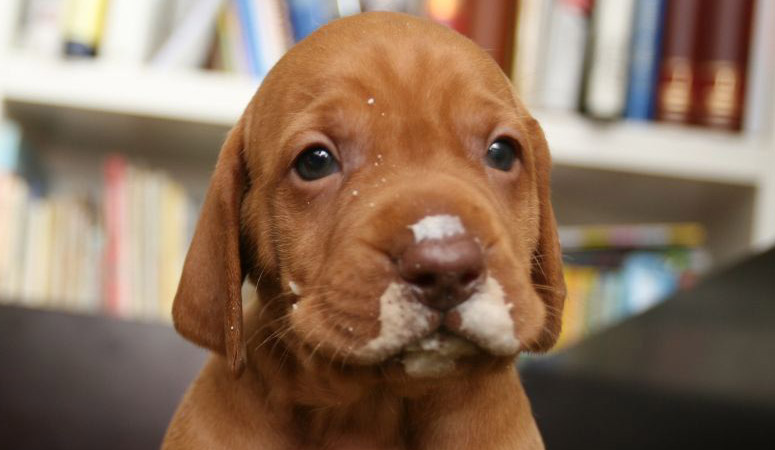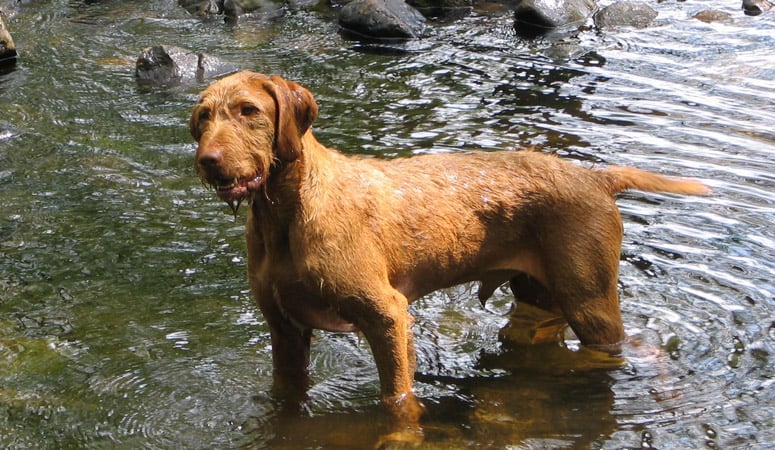Wirehaired Vizsla
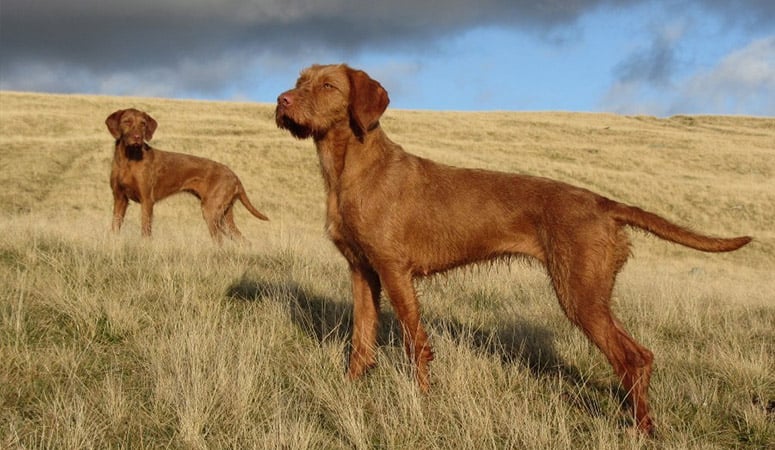
The Wirehaired Vizsla is a dog breed originating in Hungary, his dense, wiry coat distinguishes him from his close cousin, the Vizsla. This breed is energetic, caring, quiet, and gentle, and they are known as excellent hunting dogs, and also loving and affectionate companions for families.
| Other Names | Drótszőrű magyar vizsla, Hungarian Wirehaired Vizsla |
| Color | Golden Rust, Golden, Red, Red Golden, Rust, Rust Golden, Sandy Yellow |
| Height | Males: 22-25 inches. Females: 21-24 inches. |
| Weight | Males: 44-66 pounds. Females: 44-66 pounds. |
| Life Span | 12-14 years |
| Personality | Gentle, Loyal, Trainable |
| Exercise | Energetic |
| Origin |
| Popularity | #145 |
| Groom Needs | Occasional |
| Kids Friendly | Yes with supervision |
| Dog Friendly | Yes with supervision |
| Watch Dog | |
| Family Dog | |
| Litter Size | 6-7 |
Wirehaired Vizsla Pictures
Wirehaired Vizsla Video
Introduction
The Wire-haired Vizsla is a medium-sized dog with a wiry coat which is golden-sand to a russet color. You will notice his face has a prominent ‘mustache’ and hairy eyebrows. The dog stands about 25 inches at the shoulders and weighs around 65 pounds. The Hungarian Wire-haired Vizsla enjoys being outdoors and is ideally suited to a country-dwelling family. They are very affectionate and loyal and naturally protective of their loved ones. They learn quickly and always want to please the owners. They are very sensitive though, and so it’s especially important that training is fun and gentle. The Wire-haired Vizsla requires plenty of exercise to keep active – he will require a minimum of 2 hours of exercise a day. His beautiful golden coat will require weekly grooming to get rid of loose hairs. They’re good watchdogs, too, with strong vocal cords and good hearing. Protective and territorial about their property, they always alert you to something that is not right. It’s this simple – if you are lazy and don’t want to spend any time with your dog, don’t consider the Vizsla!
Living with Wirehaired Vizsla
When it comes to grooming, the Wirehaired Vizsla just needs little maintenance. An occasional once-over with a firm bristle brush is helpful to keep his harsh coat in good shape. And during the shedding season, it is required to use a grooming mitt or shedding knife on their coat to keep down the amount of hair that your dog sheds in your home. After a hunting trip or other swampy adventure, a bath with mild soap or shampoo products is necessary for your dog. Bath time provides an excellent opportunity for owners to check for nicks, scratches, thorns, ticks, fleas, or other conditions that may need attention.
It is suggested to begin a dental care regimen at an early age to avoid problems later in life, and trim the nails about every four weeks.
The Wirehaired Vizslas are active hunting dogs, and they need both physical and mental exercise. They require plenty of exercise at least an hour every day which could be long walks, training sessions, and playtime. If not given enough exercise, they may be overactive and destructive.
Most dogs need chances to run hard off-leash on a regular basis besides leash walks and games of fetch. More importantly, mental exercise is essential as well as physical activity, so it is recommended to add the training sessions to your dog’s exercise routine. These dogs also do well when trained for dog sports like agility or for hunting.
The Wirehaired Vizsla is a medium-sized dog and should be offered a dog food diet that is formulated for dogs of that size. More importantly, the food amount should depend on the dog’s weight, size, age, and activity level.
Some dogs are easy to get overweight, so you need to watch their calorie consumption and weight level all the time. Treats may be an important aid in training, but excessive intake can lead to obesity. Also, owners need to distinguish which human food is safe for dogs and which are not. If you have any problems with your dog’s weight or diet, just consult from your veterinarian.
The Wirehaired Vizslas are prone to the following health conditions: Addison’s Disease (hyperadrenocorticism), autoimmune hemolytic anemia, Cushing’s Disease (hypoadrenocorticism), inflammatory bowel disease, hip dysplasia, elbow dysplasia, metabolic muscle disease, epilepsy, progressive retinal atrophy (PRA), etc.
Major concerns: epilepsy
Minor concerns: CHD, lymphosarcoma
Occasionally seen: hypothyroidism, PRA, tricuspid valve dysplasia, persistent right aortic arch, vWD
Suggested tests:
Hip Evaluation
Ophthalmologist Evaluation
Total Annual Cost: $2889
Cost is estimated for the first year and may vary depending on many factors, such as dog food, health care, leash, collar, licensing, possible fencing, crates, training and obedience classes, dog-walking, grooming, treats, toys, flea, tick, and heart-worm meds, microchips, etc.
Wirehaired Vizslas are very smart dogs and eager to please, so they could be easily trained. And the dog should get consistent and positive training from puppyhood. Early and ongoing socialization is important to make sure the dog has the confidence to enjoy various activities because it is a sensitive breed. They have a strong bond with their families and can develop separation anxiety without proper conditioning.
With a firm and consistent hand in training and use positive reinforcement-based training methods, the dog can perform well in a variety of dog sports. The Wirehaired Vizsla can be trained for a variety of dog sports including agility, tracking, pointing, retrieving, and obedience.
History
The Wire-haired Vizsla originates from Hungary. They guarded and herded livestock, hunted and tracked wild animals. Later they would accompany barons and lords when they hunted for sport.
It was selective breeding that developed the Vizsla to be a hunter, a pointer, and a retriever dog. In the 1930s, the wire-haired Vizsla was developed. It was popular with the hunters because it could endure the colder climates and cold water than the Vizslas with the short hair.
There are stone etchings which confirm that the dogs have been around for over a thousand years. The dogs in the etchings are very similar to the Wire-haired Vizsla. As the Magyars traveled to other countries, their dogs went with them, and this led to crossing with other breeds.
During the two World Wars, this dog breed almost disappeared and only is around today thanks to some being smuggled out.
In 1950, the first Vizsla arrived in America. Then 50 years later, a beauty called Chartay became the first dog in AKC history to earn himself a quintuple championship!
Have you ever read the story of Kubrick The Dog, by Sean Ellis? It’s an amazing story of a Hungarian Vizsla, predestined to become a photo model. He posed alongside famous models, often stealing the show from them. The British fashion designer Stella McCartney posed many times with Kubrick.
They became a fully recognized breed at the AKC in 2014.
Helpful Information
Breed Club: WIREHAIRED VIZSLA CLUB OF AMERICA
Breed Club Link: https://whvca.org/
Breed Club Rescue:
Breed Club Rescue Link: https://whvca.org/rescue/

